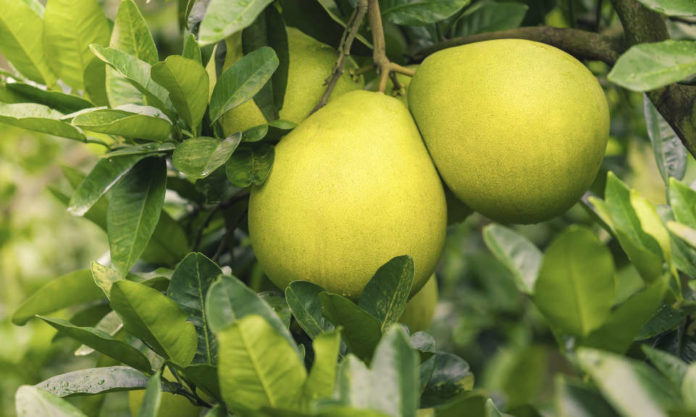It’s pomelo season in Jiangnan. That pleases me.
Even if you don’t know its (obscure) English name, you know the fruit. It hangs, moon-like, from trees in parks and campuses everywhere. You can eat the windfalls, but they’re a little too sour. Thankfully, bigger, more-user-friendly versions of these yellow globes appear in stores. Open them up to find segments each as big and tactile as a Nokia phone. These segments are red (slightly more expensive) or “yellow” (cheaper and just as good), partitioned by a tough white pith. Unlike, say, a clementine, you can easily remove the pith without damaging the fruit or getting your hands sticky-wet! Crescent clusters of capsule happiness.
I’m a citrus fan. But I’ll admit that grapefruit is a little sour for me. So I adore the pomelo as a perfect median between the grapefruit and the orange. It’s simply the favourite fruit of this fan.
Yet part of me has always wondered whether this “perfect median” is a bit of a contrivance. Even the spectre of genetic modification has troubled me. Are these just grapefruits tamed for wimps, I wondered.
Well, further research into this citrus spectrum quickly revealed a number of surprises; firstly that the grapefruit is itself a hybrid. So, too, are lemons, limes and oranges, apparently. Who’d have thought it!
- Apocalypse Tea; Should I Drive After Drinking This?
- Swallowing is Just the Beginning; Rain, Flower, Cloud!
- Sugar-Free Bottled Tea; China’s Wu Tang Clan
But it’s not the result of some shady CRISPR gene-editing sorcery; it’s just the way that humans have cross bred and selectively bred different variants for different purposes; some for munching, some for “spice”, some for perching on a Martini.
And the pomelo, it turns out, is not a hybrid; it’s an elemental citrus totem. So, too, is the bergamot. And the bergamot is partly the point of today’s Strainer.
You may well be a big fan of this flavour. It’s increasingly appearing in milk tea stores and even bottled tea drinks in China. Though used in winter desserts in Italy and other Mediterranean countries, this citrus fruit is best known internationally as the “Earl Grey” flavour. I understand there is no pleasure at all in eating a bergamot.
China has no native bergamots. It’s not part of the culinary tradition here, never mind the tea culture. Perhaps in China, jasmine occupies the same place as the default non-tea ingredient used in tea production. Both of these strong-smelling substances are stored with the tea leaves, rather than included in the final teabag / loose selection (Lady Grey tea, incidentally, combines both jasmine and bergamot).
- Which Tea Brand Best Compliments Your Private Jet?
- Long Time, Long Jing No See
- Happy Lemon; Drink it Like a Russian
China also doesn’t have much of a tradition of pairing black tea with lemon, a la Russian samovar.
But there is a citrus tea with a real following in China; the pu’er tangerine.
The wet fruit is somehow channeled away, Houdini- style, without damaging the spherical form of the skin. Loose pu’er tea is stuffed, ship-in-a-bottle style, into the cavity. Aging happens (somewhere in West or North China, probably) and the peel becomes leathery and far less orange.
The tangerine peel is much more than just neat packaging; the two elements infuse together tastily and consistently. As I write, I’m drinking a lime variant of this formula. It works well, the sprightly oils in the peel complementing the old-book wisdom of the pu’er.
Even before discovering this, I knew about peel. Since marrying a Beijinger, I have laid out my tangerine skins on the radiator, occasionally making a hot drink from them. But I never spontaneously thought of pairing them with pu’er. It’s easy to do, and well worth trying, especially if your local tea seller doesn’t sell the wonderful tea balls themselves.
Winter is coming. And there’s a tea for that, too.









